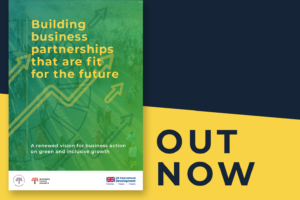The following blog entry is a cross-post from my blog Realizing Your Worth.
 Volunteer rates are down, but more people are talking about the importance of volunteering. There’s a disconnect. Here’s why, and what you can do about it.
Volunteer rates are down, but more people are talking about the importance of volunteering. There’s a disconnect. Here’s why, and what you can do about it.
Outside there’s an audible hum, and it’s increasing in volume by the minute. People are talking about the things that matter, the causes that move them, the communities they love. They are talking about the need to get more active, more involved. Apparently society has decided to give back like never before, and they have decided to do it through volunteering.
Or…..have they?
Non-profit executives and volunteer managers will tell you a different story. From their perspective, fewer people are showing up and fewer still are willing to make the necessary commitments. Not only that, but the volunteers seem more selfish. The question has become, “What am I getting out of the experience of volunteering?” rather than “What am I giving?” And the widespread popularity of Corporate Volunteering programs only multiply these frustrations.
The thing is, it’s true. People are very interested in volunteering, yet less willing to make long-term time commitments. They are socially aware, yet seem concerned with program outcomes and personal fulfillment rather than the value of “doing the right thing.” Oddly, (despite the fact that many volunteer managers struggle with recruiting new volunteers) volunteer rates are, in fact, steadily increasing. People are far more active and informed than ever before. Each week hundreds of corporations are looking to formalize a volunteering program and mobilize employees in their communities.
So where’s the disconnect? If more people care, and more people are actually volunteering, why are non-profit execs so frustrated? Why does it seem tougher to find and keep volunteers today than it did just two or three decades ago?
A Paradigm Shift
A major paradigm shift has taken place over the last 10 years. This shift has made recruiting and retaining volunteers more difficult – although it has nothing to do with the general interest or willingness to commit to making a difference.
SHIFT ONE: From card catalogs to wifi. We have been Googleized. We now live in a world where everything and everyone are within reach all the time. When I want to see something I’ve never seen, learn something I don’t know, or meet someone for the very first time, I can. And within about .06 seconds. The speed is amazing, but the real power lies within the potential for connection. Through social media sites like LinkedIn and Twitter I have discovered experts and thought leaders in my field, connected with them, and expanded conversations. Nothing is off-limits to me. No experience is too far away, no culture too removed. My expectations are high because the world is my oyster.
IMPACT: As a culture we expect real and immediate connections. Googlelized volunteers will not appreciate being assigned to stacking boxes. They will not value sweeping up after. When you hand them printed material to walk out with, expect to see it in the recycling bin by the door. Not good enough. Not anymore.
Today’s expectation is for direct connections with outcomes and with people. My interest is captivated by the opportunity to give a goat to a village in Kenya because I can learn about the area, it’s history, the people living there – even the names of the family who received my goat. Giving to an amorphous cause to fight hunger is simply not the same. I can’t make it part of my own story. The same is true for volunteering.
In order to underscore the importance of this shift, I’ve included the following video about Social Media and it’s implications for everyday life. A special thanks to Heidi Massey for sending this along to me (We’ve never met, but we are fast “social media” friends – Heidi’s blog).
SHIFT 2: From finding the right job to becoming the right brand. We are now in an era where we seek to create a personal brand, rather than find a good job. This trend has been burgeoning for decades and has reached a point where few people expect to work at one company until retirement. We are now free to choose from an array of experiences. From interviewing for an interesting position, to stepping up as an entrepreneur, we can create the life we want – the life we dream of. A good job is no longer synonymous with a sense of security. Instead, options equal security. Instead of retirement at the age of sixty, we expect to have an increasingly valuable brand, with specialized possibilities to choose from. Forget retirement, we’re just getting started.
IMPACT: Very few people can or want to make long-term commitments. This is not something to fight against – it is simply the new reality. Non-profits who continue to ask for long-term commitments of a few months, let alone a year, will continue to experience disappointment. The “good” of the cause or the quality of the program will not make a difference. Unless the volunteer happens to have a pre-existing vested interest in the organization, the lifestyle of this new paradigm will allow only disdain for long-term commitment.
SHIFT 3: From commodity to experience. Not too long ago, we were all farmers, extracting the commodities we needed from the earth. Then came the Industrial Revolution and the factories that enabled us to transform those raw commodities into goods to sell. Over the past century the gross domestic product of most developed nations switched from primarily manufacturing goods to that of offering services. Recently, we’ve personalized these services to an even greater extreme. We are becoming an economy of experience.
A perfect example of this is coffee. Beginning as a commodity, coffee is simply a bean taken from the earth. From there, coffee is transformed into a good, sold in stores. It becomes a service when you receive it from your favorite coffee shop in the morning. But if you want to take coffee to the next step, you need to go to that great Third Place. Starbucks. At Starbucks, you’re not just buying coffee, you’re buying the coffee experience- right down to cushy chairs, cool music, modern decor, and free wifi. Starbucks barely sells coffee. Mostly, they sell experience. And most of us are more than willing to pay for it.
Joseph Pine does an exceptional job of presenting these insights in a talk he delivered at TED.
IMPACT: Volunteering needs to be an “experience first” event. Sure, people will show up to paint a wall if that’s what’s needed, and the invitation is clear and urgent. But if you want to keep those volunteers, and attract even more, then the focus must be on the experience of the volunteer, not the task that they are performing. We all know when we are a means to an end. And most of us are cool with that if we believe in the cause. But in most cases, people must be provided an experience in which they can personalize their volunteer work, and internalize their motivations for being there. (For more explanation on motivation and volunteering read this blog post: Want Good Volunteers?)
Shifting gears
People are googleized, branded and experiential. If those of us who recruit and manage volunteers are going to be successful, we’ve got to account for these changes. Here are some initial thoughts that might encourage the necessary adjustments:
- Create regular and easy opportunities to volunteer. And I mean really easy. No police checks. No lengthy registration forms. No liability forms. No prior-to event sign up. Instead, find an event that can be held once a month, if not weekly. Make it easy for groups, families as well as individuals to attend. Most organizations I’ve worked with cannot even imagine how this is possible. It is. It just takes a little work, and some imagination. Mostly, it takes a willingness to admit that the thing not working now, aren’t going to start working anytime soon. Like it or not, change is required.
- Instead of using volunteers as a means to an end, use the tasks volunteers perform as the means to an end. It is the experience volunteers have and not the tasks they perform that is the point. Focus on the experience, and you’ll discover the commitment and productivity of your volunteers grow.
- Ensure that the experience involves close proximity between your community or cause and your volunteers. This is an essential part of volunteers internalizing the experience and discovering very personal and compelling reasons to invest in your organization.
- Only spend time on people who are worth spending time with. (Trust me. Sometimes the seemingly selfish moves are the best for everyone in the long run.) If people come back, and they demonstrate a keen interest in what you’re doing as an organization, then they are the prime candidates for your efforts.
Chris Jarvis Senior Consultant, Realized Worth, Toronto, Canada 416-567-2004
Email me; ch*********@re***********.com
Join our Facebook Page
Follow me on Twitter @RealizedWorth
Check out My LinkedIn Profile










